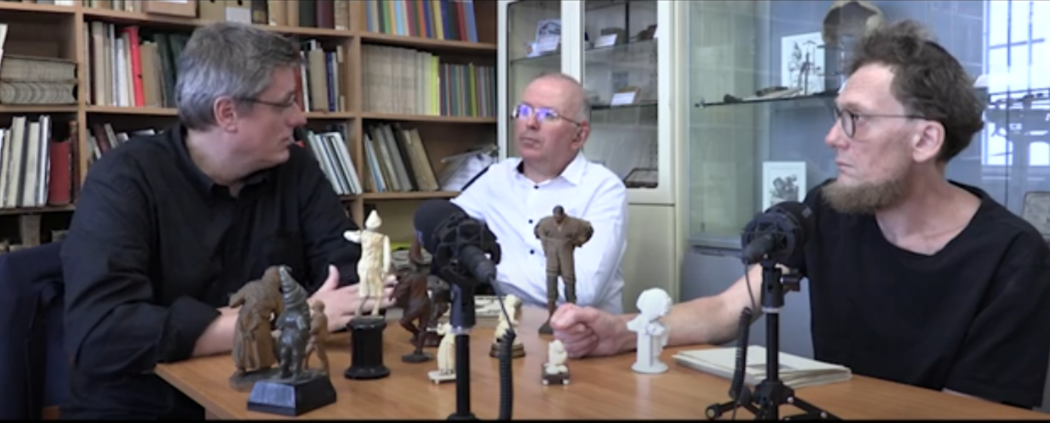Accessibility and Archives: Lost and Found: The Hans Würtz Collection
Professor Simon Mckeown undertakes research and teaches at the School of Arts and Creative Industries at Teesside University, Middlesbrough, UK in the fields of fine art, digital creativity and disability. He is a disabled practicing artist as well as a disability heritage specialist. In the first of a two-part blog, he explores a historic collection of images and representations of disability first assembled by Hans Würtz (1875–1958) against the backdrop of rising National Socialism in Germany.
In 2013, the exhibition Disabled by Normality was presented at Prague’s DOX Centre for Contemporary Art. Curated by Jaroslav Anděl and Kateřina Kolářová, with curatorial support from Leoš Válka and Michaela Šilpochová (DOX), it was organised in collaboration with the Jedlička Institute and Schools and the National Medical Library both in Prague. Critically, it marked the first public unveiling since 1932 of a long-lost collection of artworks representing disabled people—resurrecting not just art, but forgotten history.
At the turn of the twentieth century, German pedagogue Hans Würtz (1875–1958) assembled a vast collection of disability-related artworks. Active between 1910 and 1932, his work unfolded against the backdrop of rising National Socialism. In 1932, as director of the Oskar Helene Heim disability institute, he curated an exhibition featuring figurative depictions of disabled people. This bold move led to his arrest and the eventual loss of most of his Collection to the Czech Republic, where it has since remained largely unknown.
Hans and Rosa Wurtz
More than a cabinet of curiosities, Würtz’s “Collection” offers a rare cultural perspective on disability. He was a pioneer who challenged the dominant medical view of impairment, shifting the lens toward cultural expression. His work remains both socially and artistically significant—particularly in spaces where representations of disabled people are scarce or fraught, such as museums and the media.
Originally comprising over 7,000 items, the Würtz Collection today includes 3,142 pictures, 14 oil paintings, 175 sculptures, and 1,221 glass plate negatives. Loss, theft, and redistribution have significantly reduced its size. It remains unclear how much of the core material is now dispersed across European institutions—and whether restitution claims might be warranted.
Remarkably, the Collection survived WWII, bombing, flooding, and sweeping political upheavals including Nazism, Communism, and the 1989 Velvet Revolution. In the 1970s, it was divided in Prague: the largest portion resides in the Historical Archive of the Jedlička Institute; a smaller part, including all sculptures, was transferred during the Communist era to the National Medical Library in Prague. A third, much smaller portion is held at the Special Education Archive at Humboldt University in Berlin. After WWII, boxes containing thousands of glass negatives were discovered in the basement of the Oskar Helene Heim in Berlin—capturing visual records of the institute and elements of the Collection. Alongside manuscripts, letters, and a few additional images gathered by Würtz’s widow Rosa, this material formed the “Hans Würtz Archive” held at Humboldt University in Berlin.
The Würtz Collection stands as a singular repository of new knowledge, revealing that representations of disability in art long predate modern figures like Frida Kahlo. Within the Collection, distinct groupings—particularly of figurative sculpture—suggest the presence of artists or studios deliberately creating images of disabled people for public viewing, collection, and purchase. Some of these works appear to draw directly from Jacques Callot’s (1592–1635) Grotesque Dwarves series, which likely inspired both porcelain and bone-carved pieces in the archive. We also believe that original prints by Callot are housed within the Collection itself.
Statuette of an amputee
Spanning centuries and encompassing diverse materials and media, the Würtz Collection powerfully illustrates the ubiquity of portraits and visualisations of disabled people throughout art history. To our knowledge, no museum has matched the depth of insight it offers. As scholarship like Beyond the Footnotes[1] and initiatives such as Curating for Change[2], increasingly call for greater disabled representation, the Würtz archive emerges as a vital exemplar—one that deserves a central place in museological discourse and practice.
Statuette of blind organ grinder
Würtz envisioned this Collection as a foundation for an interdisciplinary cultural approach to disability. As a pedagogue, he also sought to demonstrate that disabled people need not be cast solely as recipients of charity but as individuals capable of work and success. Nearly a century later, disability remains underrepresented and often misrepresented in museums—frequently filtered through outdated or voyeuristic perspectives.
What stands out in our analysis is the rare opportunity for disabled people to see and enjoy ourselves represented in art history through the Collection. It reflects the lived experience of disability—whether fanciful, faithful, or cruel—in both two and three dimensions. I know of no other location that does this. Here, disability is explored with depth and complexity, not relegated to a passing mention or a footnote in a broader narrative.
What remains unclear—due to the Collection’s lack of provenance—is how and why many of these objects were created. Were disabled people the makers, the artists, the designers? Or were they simply the subjects? And how does this shape the way we interpret the Collection? I hope, and suspect, that in some cases disabled artisans and craftspeople carefully depicted both disabled and non-disabled figures for an appreciative (buying and collecting) audience.
In conclusion, the Collection holds immense cultural value and offers rich, largely unexplored material for analysing historical images and cultural conceptions of impairment and disability. At the time, progressive sections of the Berlin press described the Collection as 'unique' and called for its inclusion in a museum. Würtz himself recognised this, stating that his collection should serve as an inspiration for historians, artists, philosophers, psychologists, educators, and writers (Würtz 1932, 73)[3].
I feel immensely proud to have helped Würtz’s aims and to have jointly led the Collection back to Berlin.
Musenbury, Mckeown and Krysl with objects from the collection
Credits:
Images of Disability is a collaborative project made possible through funding from the UK Arts and Humanities Research Council (AHRC) and the German Research Foundation (DFG) with the support of Teesside University, Middlesbrough, UK, Humboldt-Universität zu Berlin, Germany and in partnership with the National Medical Library, Prague, Czech Republic and the Jedlička Institute and Schools, Prague, Czech Republic with thanks to DOX Centre for Contemporary Art without whom this project would not have been possible.
Text © Simon Mckeown 2025 / Images © respective owners as detailed above
[1] Dodd, Jocelyn et al (2004): Buried in the Footnotes: The Representation of Disabled People in Museum and Gallery Collections
[2] https://curatingforchange.org/
[3] Würtz “Smash the Crutches”, Berlin 1932




